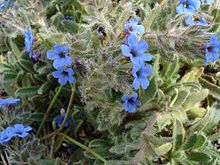Alkanna tinctoria
| Alkanna tinctoria | |
|---|---|

| |
| Dyer's bugloss | |
| Scientific classification | |
| Kingdom: | Plantae |
| Clade: | Tracheophytes |
| Clade: | Angiosperms |
| Clade: | Eudicots |
| Clade: | Asterids |
| Order: | Boraginales |
| Family: | Boraginaceae |
| Genus: | Alkanna |
| Species: | A. tinctoria
|
| Binomial name | |
| Alkanna tinctoria (L.) Tausch
| |
Alkanna tinctoria, the dyer's alkanet[1] or simply alkanet, is a herbaceous flowering plant in the borage family Boraginaceae. Its roots are used to produce a red dye. The plant is also known as dyers' bugloss, orchanet, Spanish bugloss, or Languedoc bugloss. It is native to the Mediterranean region. A. tinctoria has 30 chromosomes and is regarded as a dysploid at the tetraploid level (4x + 2).[2]
A. tinctoria has a bright blue flower. The plant has a root of blackish appearance externally, but blue-red inside, with a whitish core. The root produces a fine red colouring material, which has been used as a dye in the Mediterranean region since antiquity. The dyestuff in its roots is soluble in alcohol, ether, and oils, but is insoluble in water. It is used to give colour to wines and alcoholic tinctures, to vegetable oils, and to varnishes.
Powdered and mixed with oil, the alkanet root is used as a wood stain. When mixed into an oily environment, it imparts a crimson color to the oil, which when applied to wood moves the wood's color towards dark-red-brown (resembling that of rosewood), and accentuates the grain of the wood.[3]
Alkanet is also traditionally used in Indian food under the name ratan jot, and lends its red colour to some versions of the curry dish rogan josh. In Australia, alkanet is approved for use as a food colouring, but in the European Union, it is not.
It has been used as colorant for lipstick[4] and rouge.
In alkaline environments, alkanet dye is blue; in the presence of acids it gradually changes to crimson.[5] The colour is red at pH 6.1, purple at 8.8 and blue at pH 10.
The colouring agent in A. tinctoria root has been chemically isolated and named alkannin.
In folk medicine, it is also used to treat abscesses and inflammations.[6]
In English in the late medieval era, the name alkanet meant A. tinctoria.[7] In the centuries since then, the name has come to be used informally for some botanically related other plants; see Alkanet.
References
[edit]- ^ BSBI List 2007 (xls). Botanical Society of Britain and Ireland. Archived from the original (xls) on 2015-06-26. Retrieved 2014-10-17.
- ^ Ahmad, Muhammad; Leroy, Thibault; Krigas, Nikos; Temsch, Eva M.; Weiss-Schneeweiss, Hanna; Lexer, Christian; Sehr, Eva Maria; Paun, Ovidiu (14 July 2021). "Spatial and Ecological Drivers of Genetic Structure in Greek Populations of Alkanna tinctoria (Boraginaceae), a Polyploid Medicinal Herb". Frontiers in Plant Science. 12: 706574. doi:10.3389/fpls.2021.706574. PMC 8317432. PMID 34335669.
- ^ "Alkanets" in A Modern Herbal, by Mrs. M. Grieve, year 1931.
- ^ The Complete Servant, by Samuel and Sarah Adams, year 1826.
- ^ "Alkanet" in Dispensatory of the United States of America, year 1918, edited by Joseph P. Remington and Horatio C. Wood.
- ^ Duke, James A. (2002). Handbook of medicinal herbs (2nd ed.). Boca Raton, FL: CRC Press. ISBN 0849312841. OCLC 48876592.
- ^ Alkanet in the Middle English Dictionary
Attribution
 This article incorporates text from a publication now in the public domain: Ward, Artemas (1911). "The Grocer's Encyclopedia". The Grocer's Encyclopedia.
This article incorporates text from a publication now in the public domain: Ward, Artemas (1911). "The Grocer's Encyclopedia". The Grocer's Encyclopedia.
